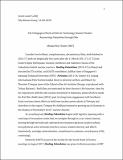| dc.contributor.author | Fischer, Michael M. J. | |
| dc.date.accessioned | 2020-02-21T20:44:59Z | |
| dc.date.available | 2020-02-21T20:44:59Z | |
| dc.date.issued | 2019-06 | |
| dc.identifier.issn | 1875-2160 | |
| dc.identifier.issn | 1875-2152 | |
| dc.identifier.uri | https://hdl.handle.net/1721.1/123842 | |
| dc.description.abstract | Consider two brilliant, complementary, documentary films, both finished in 2016–17, both set diegetically five years after the 11 March 2011 (“3.11”) Great Eastern Japan Earthquake, tsunami, meltdown, and radiation release of the Fukushima Daiichi nuclear reactors. Healing Fukushima (2016–17) is filmed and directed by STS scholar and EASTS contributor Sulfikar Amir of Singapore’s Nanyang Technical University (NTU). Furusato (2011–16, winner of a Leipzig International Film Festival Golden Dove) is directed, written, and filmed by Thorsten Trimpop (now of the School of the Art Institute Chicago; coproduced with Tobias Büchner). Both films are motivated by their director’s life histories: Amir, by his experiences with the antinuclear movement in Indonesia, about which he made his first film, Nuklir Jawa (2012), part of a long-term engagement with Southeast Asian wariness about efforts to build new nuclear power plants in Vietnam and elsewhere in the region; Trimpop, by his childhood memories growing up in Germany in the shadow of Chernobyl’s level-7 nuclear disaster. | en_US |
| dc.language.iso | en | |
| dc.publisher | Duke University Press | en_US |
| dc.relation.isversionof | http://dx.doi.org/10.1215/18752160-7340994 | en_US |
| dc.rights | Creative Commons Attribution-Noncommercial-Share Alike | en_US |
| dc.rights.uri | http://creativecommons.org/licenses/by-nc-sa/4.0/ | en_US |
| dc.source | Prof. Fischer via Ece Turnator | en_US |
| dc.title | The Pedagogical Work of Film for Technology Disaster Studies: Reassessing Fukushima through Film | en_US |
| dc.type | Article | en_US |
| dc.identifier.citation | Fischer, Michael M. J. "The Pedagogical Work of Film for Technology Disaster Studies: Reassessing Fukushima through Film." 13, 2 (June 2019): 345-354 © 2019 Ministry of Science and Technology, Taiwan | en_US |
| dc.contributor.department | Massachusetts Institute of Technology. Anthropology Program | en_US |
| dc.contributor.department | Massachusetts Institute of Technology. Program in Science, Technology and Society | en_US |
| dc.relation.journal | East Asian Science, Techonology and Society: An International Journal | en_US |
| dc.eprint.version | Author's final manuscript | en_US |
| dc.type.uri | http://purl.org/eprint/type/JournalArticle | en_US |
| eprint.status | http://purl.org/eprint/status/PeerReviewed | en_US |
| dc.date.updated | 2020-02-13T17:49:06Z | |
| dspace.date.submission | 2020-02-13T17:49:08Z | |
| mit.journal.volume | 13 | en_US |
| mit.journal.issue | 2 | en_US |
| mit.license | OPEN_ACCESS_POLICY | |
| mit.metadata.status | Complete | |
